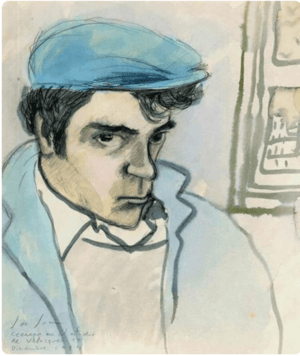Ceesepe facts for kids
Quick facts for kids
Carlos Sánchez Pérez
|
|
|---|---|

Ceesepe painted by Javier de Juan in 1984
|
|
| Born | 31 May 1958 Madrid, Spain
|
| Died | 7 September 2018 (aged 60) Madrid, Spain
|
| Other names | Ceesepe |
| Occupation | Painter and comics artist |
| Honours | Gold Medal of Merit in the Fine Arts |
Carlos Sánchez Pérez (born May 31, 1958 – died September 7, 2018) was a famous Spanish painter, comics artist, and illustrator. He was known by his professional name, Ceesepe.
Ceesepe was especially good at creating drawings and collages. His unique art style is often called pop art, which uses images from popular culture. He was a very important artist during a time in Madrid called La Movida Madrileña. This was a period of great cultural change and artistic freedom in the 1980s. His nickname "Ceesepe" comes from how his initials C.S.P. sound when spoken in Spanish.
In 2011, Ceesepe received a special award from Spain. It was the Gold Medal of Merit in the Fine Arts, given for his amazing contributions to art.
Contents
About Ceesepe's Life
When Ceesepe was sixteen, in the mid-1970s, he discovered the world of underground comix. These were independent comic books. He met artists and illustrators from Barcelona, like Max and Javier Mariscal. He worked with them in Barcelona until 1979.
Ceesepe became one of the most popular painters during the artistic boom of La Movida Madrileña. During this time, he created many different types of art. This included screen prints, posters for movies, album covers for music, and various illustrations.
"My older brother drew and my father and grandfather were carpenters. I was in art school for like a month and left it. That's all my artistic training. There were a lot of people there that drew better than me. I could spend a week with a drawing that they did in a day, and mine would be half crooked, but they knew it was mine."
—Ceesepe, Vanity Fair
His Work in Comics and Film
Ceesepe published his first cartoon series, Slober, in several magazines. These included Star, Bésame Mucho, El Víbora, Madriz, and La Luna de Madrid.
He also designed the poster for Pedro Almodóvar's first full-length film, Pepi, Luci, Bom (1980). Later, Ceesepe himself would go on to create eight films.
"The time that most interests me is the birth and expansion of photography and painting's reaction to that. There are some years of convergence of many things and concepts that for me are still valid."
—Ceesepe
Ceesepe's Unique Art Style
Ceesepe developed a very special art style. He was influenced by many different artists. Some of his main influences came from British pop art artists like Peter Blake and Peter Phillips. He also looked to older artists such as Henri de Toulouse-Lautrec, Amedeo Modigliani, and Marc Chagall.
His first solo art show was in 1979 at the Buades gallery in Madrid. In 1982, the Menéndez Pelayo International University showed some of his work. Two years later, in 1984, he became one of the best-selling artists at the Arco art fair.
One of his cartoon strips caused some debate. It included references to political figures. This led to a group called People's Alliance criticizing the magazine Madriz and the City Council of Madrid, which had supported the magazine.
Later Years and Exhibitions
In the mid-1980s, Ceesepe stopped making comics. He then focused mostly on painting. He held art shows in many cities around the world. These included Amsterdam, Paris, Angoulême, Geneva, Bali, New York City, and Madrid. In 1984, he took part in a group exhibition at the Fundació Joan Miró in Barcelona.
He continued to create film posters, like the one for Almodóvar's Law of Desire (1987). In his later years, he designed covers for the Spanish edition of Rolling Stone magazine. The New Yorker magazine also hired him to design one of their covers in 1993.
His artwork has been collected in several books. Some of these include Dibujos (1982), Barcelona By Night (1982), París-Madrid (1985), El difícil arte de mentir (1986), Libro blanco (1990), and Ars morundi (1990).
Ceesepe passed away in Madrid on September 7, 2018, at the age of sixty.
Images for kids
-
Commemorative plaque at the site of Ceesepe's former studio in Madrid
See also
 In Spanish: Ceesepe para niños
In Spanish: Ceesepe para niños



